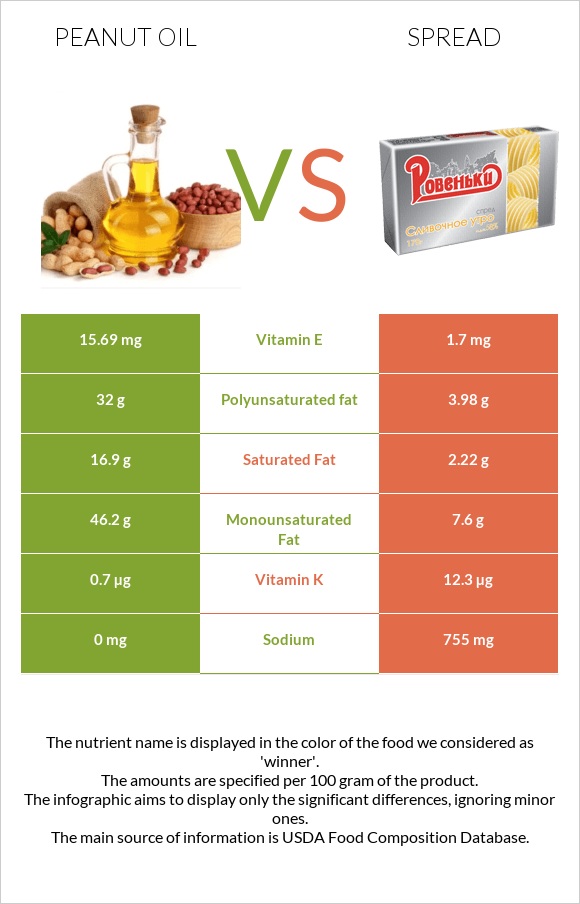Peanut oil vs. Spread — In-Depth Nutrition Comparison
Compare
What are the differences between peanut oil and spread?
- Peanut oil is higher in vitamin E, monounsaturated fat, and polyunsaturated fat, yet spread is higher in vitamin A and vitamin K.
- Peanut oil's daily need coverage for vitamin E is 93% more.
- Peanut oil has 8 times more polyunsaturated fat than spread. While peanut oil has 32g of polyunsaturated fat, spread has only 3.98g.
- The amount of saturated fat in spread is lower.
We used Oil, peanut, salad or cooking and Margarine-like spread, SMART BEAT Super Light without saturated fat types in this article.
Infographic

Infographic link
Mineral Comparison
Mineral comparison score is based on the number of minerals by which one or the other food is richer. The "coverage" charts below show how much of the daily needs can be covered by 300 grams of the food.
| Contains more IronIron | +∞% |
| Contains more ZincZinc | +∞% |
| Contains less SodiumSodium | -100% |
| Contains more PotassiumPotassium | +∞% |
Vitamin Comparison
Vitamin comparison score is based on the number of vitamins by which one or the other food is richer. The "coverage" charts below show how much of the daily needs can be covered by 300 grams of the food.
| Contains more Vitamin EVitamin E | +822.9% |
| Contains more Vitamin KVitamin K | +1657.1% |
All nutrients comparison - raw data values
| Nutrient |  |
 |
DV% diff. |
| Polyunsaturated fat | 32g | 3.98g | 187% |
| Fats | 100g | 17.1g | 128% |
| Monounsaturated fat | 46.2g | 7.6g | 97% |
| Vitamin E | 15.69mg | 1.7mg | 93% |
| Saturated fat | 16.9g | 2.22g | 67% |
| Calories | 884kcal | 158kcal | 36% |
| Sodium | 0mg | 755mg | 33% |
| Vitamin K | 0.7µg | 12.3µg | 10% |
| Potassium | 0mg | 12mg | 0% |
| Iron | 0.03mg | 0% | |
| Zinc | 0.01mg | 0% | |
| Trans fat | 2.45g | N/A | |
| Choline | 0.1mg | 0% |
Macronutrient Comparison
Macronutrient breakdown side-by-side comparison
Protein:
0 g
Fats:
100 g
Carbs:
0 g
Water:
0 g
Other:
0 g
Protein:
0 g
Fats:
17.1 g
Carbs:
0 g
Water:
80.83 g
Other:
2.07 g
| Contains more FatsFats | +484.8% |
| Contains more WaterWater | +∞% |
| Contains more OtherOther | +∞% |
~equal in
Protein
~0g
~equal in
Carbs
~0g
Fat Type Comparison
Fat type breakdown side-by-side comparison
Saturated fat:
Sat. Fat
16.9 g
Monounsaturated fat:
Mono. Fat
46.2 g
Polyunsaturated fat:
Poly. Fat
32 g
Saturated fat:
Sat. Fat
2.22 g
Monounsaturated fat:
Mono. Fat
7.6 g
Polyunsaturated fat:
Poly. Fat
3.98 g
| Contains more Mono. FatMonounsaturated fat | +507.9% |
| Contains more Poly. FatPolyunsaturated fat | +704% |
| Contains less Sat. FatSaturated fat | -86.9% |



